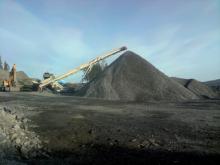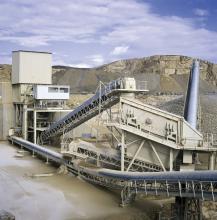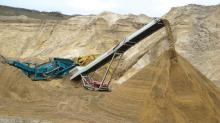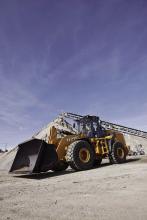Rising fuel costs and focus on lower cost per tonne production is leading to more quarries using conveyors for hauling rather than fleets of trucks
Conveyors are nothing new to the quarrying market but each year more and more quarries are opting to use them to haul material about the quarry. What has changed is not so much the design and performance of conveyors, but the factors affecting other hauling options.
The rising cost of fuel needed to power a fleet of dump trucks along with the need to more closely fix the cost per tonne of production are the main drivers of the trend towards conveyors.
"In Scandinavia we have seen a growing demand for conveyors in recent years," said Per Hansson managing director of Möckeln, which is part of the
"The reason is not just cost though - conveyors are a more environmentally friendly option as they are quieter, produce less dust and as many are electrically driven, they produce lower emissions too," he said. "In Scandinavia there is real pressure to improve environmental performance, so the benefits of conveyors have been recognised by many of the larger quarry operators here such as
"Maintenance needs of a conveyor are also lower than that of a truck," said Hansson. "The beauty of conveyors is that they are relatively simple technology and can be easily maintained." Although the design of conveyors has not changed significantly, there have been some advances in the area of belt technology. Smiley Monroe has recently launched a new Toughflex belt which is designed to last longer and minimise ripping. According to the company, the lower weight of the belt means the conveyor can carry a higher weight, while the flexibility means that the conveyor runs smoothly and troughs well.
Emerging markets
As the market for mobile crushing and screening equipment has grown in Europe, there has also been a corresponding trend towards producing tracked and wheeled conveyors. Hansson said that Möckeln has been producing such conveyors for sometime but he has noticed a growing number of models are now available. "This is an area where I think most of the growth will come," he said.
McCloskey vice president John O'Neill said, "We first produced mobile conveyors for the European market in 2004 and were surprised at the immaturity of the market compared to that in our home market of North America. The difference was down to the smaller size of sites and less stockpiling but that is changing.
"Over the last decade mobile crushing and screening equipment has gone from a maximum output of 250tonnes per hour to around 400tonnes per hour and with this higher production comes the need to stockpile and transfer material at a faster rate." According to O'Neill, it is the transportability of such equipment that has limited their production by some of the larger manufacturers. "Due to their size, stackers don't lend themselves to long distance transport," he said. "We have developed a system than can be transported by container and then only needs four to six hours assembly time. These wheeled units are a bonus for contractors who can easily move them from site to site." Another development for the mobile conveyor market, which adds further flexibility, is the move to diesel power rather than a reliance on electrical connections.
Stockpiling solutions
Gribben believes that in addition to wider use of conveyors for hauling, there is also a huge potential for the quarrying sector to benefit from telescopic radial stockpiling conveying systems.
"Radial stock piling conveyors have been used in the US and Canada for over 10 years now but in the European market it is only really the ship loading industry that uses the technology," he explained. "Telestack launched quarry specific models a few years ago and market acceptance of the concept is growing.
"The benefits will vary from site to site, but in effect they eliminate the need for a wheeled loader to create the stockpile plus they help keep the crushed material in specification and create safer stockpiles.
"Quarry operators will spend a lot of money buying the right equipment to crush and screen their aggregate to be within certain specifications but with conventional stockpiling the material can
segregate into its different gradings, so once it is delivered it is no longer in specification. Radial stockpiling conveyors effectively 'place' the material into the stockpile by telescoping and luffing rather than 'dropping' it as happens when a wheeled loader is used." According to Gribben, the other benefits are similar to hauling conveyors in the case of reduce fuel costs (from operating fewer machines) and improved safety through fewer machines moving about on site.
"The cost of operating a conveyor of this type can be 30 to 40% lower than a wheeled loader," said Gribben.
Further development
As Hansson has said, conveyors are relatively simple technology compared to other quarrying equipment and he believes that the next developments will be in developing longer conveyors. "Conveyors covering up to 10km are not unheard of in Sweden and I think that the acceptance of conveying material over such distances will grow in the next few years," he said. "This kind of technology may allow some quarries close to residential areas to continue operating."
Mobile movers
Ever growing numbers of quarries are moving from static crushing operations to mobile systems and mobile conveyors are helping such sites to get the maximum benefits. One of the latest to join the mobile revolution is Tarmac's Barrasford Quarry in Northumberland, UK which has just taken delivery of a Metso Minerals LT140 track-mounted mobile crusher, a pair of Lokolink mobile conveyors and several field conveyors.
The quarry wanted to reduce manpower and replaced a pair of static crushers and a rigid dump truck at the 135ha site and worked closely with Metso to find the right solution. Barrasford Quarry produces around 500,000tonnes per year of quartz dolorite and blue limestone.
Tarmac quarry manager Ed Dixon said that the 110tonne LT140 track-mounted mobile crusher was purchased to replace a pair of static jaws that had clocked up more than 30 years service at the site. "Having experienced the benefits of mobility, we knew that we could achieve even greater levels of productivity, safety and cost-savings by making the entire operation mobile with the purchase of the Lokolink conveyors," he said.
The arrival of the Lokolink conveyors and the field conveyors effectively replaced a pair of Cat 771 off-highway trucks and reduced the need for manpower at the face. "As a result the crushers work far more efficiently and flexibly than ever before, and we're regularly exceeding productivity levels of 400tonnes per hour," said Dixon. "The mobile plant is far more productive than our original static machines."









